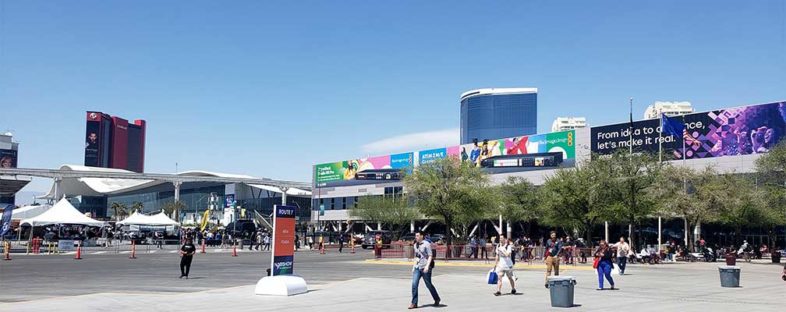NAB was happening in Las Vegas this week. I did not make it to last year’s event, which was the first NAB I have missed in over a decade. And this is also my first in person trade show or convention since 2019. But it appears that we are returning to business as usual, as I joined 65,000 of my closest friends in the industry, to wander the halls and booths of the recently expanded Las Vegas Convention Center. The addition of West Hall, and the closing of South Hall for renovations has led to a reshuffling of booth locations. Most of the post-production related vendors were moved to the North Hall, which also housed the “main stage,” full of programming for a large audience.
IP Video Options
The big theme that I saw throughout the show was video over IP, in a variety of different forms. SMPTE 2110 uncompressed video, packetized for networks, is by no means a new standard, but it is really reaching broader uses outside of large traditional broadcasting workflows, with many new products advertising support on the show floor. Throughout the rest of this article, I will just refer to it as “2110,” because it comes up a lot, but it just means uncompressed SDI data being transmitted over a standard IP network. I personally think that many use cases don’t actually need uncompressed data, but it is the lowest latency (and most expensive) solution to implement at the networking level. Compression decreases the bandwidth requirements by at least an order of magnitude, and I would imagine that 90% of content outside of movie theaters is now viewed as H.264 or similar highly compressed streams anyway, but it does add latency.
NDI is the cheapest IP video solution, offering support from a wide variety of hardware and software products, but without some of the higher end features needed for large scale deployments. Dante AV is a relative newcomer, not as widely supported, but using JPEG2000 compression to transmit a UHD (12G) signal over a standard 1Gigabit Ethernet connection. The networking costs are much lower, but the processing costs are higher, with J2K compression being processing intensive and adding some level of latency. Both NDI and Dante AV have lower bandwidth H.264 based flavors as well.
But one way or another, video is going to be moving over IP streams, as more video processing and other work is pushed into the cloud, and as more work on the edge is pushed onto the network to eventually cut costs and increase flexibility. Someday it will work smoothly, and people will hardly remember the period we are about to enter, where many things are on the network, but in all different formats and standards, and we need all sorts of other solutions to convert between them, to allow the different segments of the workflow to communicate with each other.
Whether you are using software to convert from NDI to 2110, or hardware like AJA’s new Dante AV 4K boxes to convert from SDI to Dante, or a cloud application like Cinnafilm’s Tachyon Live to do standards conversion of those IP streams, currently there are usually a lot of steps required in the pipeline to get from where we are, to where we are going.
Adobe
Adobe has announced a number of updates for their Creative Cloud applications, with a focus on video professionals, in the run up to NAB this year. The apps are getting bumped to version 23.4, and there are FrameIO improvements as well.
 Premiere Pro is getting a text based editing feature, which won a Product of the Year award at the show. It leverages the existing transcription functionality, to allow users to edit a recorded video, simply by editing the text transcript, to remove unwanted lines, etc. And all the transcription processing is now done locally, without requiring an internet connection, keeping user content safely on their own system. They are also adding a fairly impressive Automatic Tone mapping solution for mixing SDR content with HDR and Log content. Adobe Teams also has a number of incremental improvements for that shared collaborative workflow tool.
Premiere Pro is getting a text based editing feature, which won a Product of the Year award at the show. It leverages the existing transcription functionality, to allow users to edit a recorded video, simply by editing the text transcript, to remove unwanted lines, etc. And all the transcription processing is now done locally, without requiring an internet connection, keeping user content safely on their own system. They are also adding a fairly impressive Automatic Tone mapping solution for mixing SDR content with HDR and Log content. Adobe Teams also has a number of incremental improvements for that shared collaborative workflow tool.
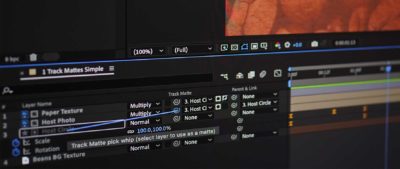 After Effects is celebrating 30 Years, and has a new universal properties panel, to bring the most frequently used settings to a central location. Essential settings that pass through pre-comps, are also accessible in the new panel, for easier editing of deeply buried options. Track mattes are now much more flexible as well. OpenColorIO is now integrated directly into the existing color management engine, for better support of ACES and other advanced color workflows.
After Effects is celebrating 30 Years, and has a new universal properties panel, to bring the most frequently used settings to a central location. Essential settings that pass through pre-comps, are also accessible in the new panel, for easier editing of deeply buried options. Track mattes are now much more flexible as well. OpenColorIO is now integrated directly into the existing color management engine, for better support of ACES and other advanced color workflows.
FrameIO, which is now under the Adobe umbrella, announced support for forensic watermarking for enterprise accounts, in addition to their existing support for live burn-ins. Camera to Cloud is expanding support for stills photographers, with better handling of non-16×9 aspect ratio assets, a side by side zooming comparison tool for still assets. Adobe also announced C2C integration in Fujifilm’s newest cameras, as well as the development application Capture One, although this doesn’t leverage the existing versioning tools the way I would expect. I am looking forward to a similar level of integration with Photoshop, as well as Illustrator and InDesign, at some point in the future.
BirdDog may not be a familiar name to many users, but they have a variety of hardware and software products in the NDI streaming and workflow space. They have a new plug-in that streams NDI data directly out of Premiere Pro, over SRT, to remote users, and easily swaps between streaming the program output, the application UI, or the webcam for face to face talks during remotely supervised editing sessions.
Avid
Avid is launching an initiative to entice students to Media Composer, with free licenses for college students and discounts for recent graduates. They were also showing closer integration between Pro-Tools and Media Composer, and remote Collaboration tool like Edit on Demand for cloud based editing, and Nexis Edge, for supporting remote users with full systems who are looking for something closer to the local experience.
 Blackmagic Design
Blackmagic Design
DaVinci Resolve is being updated to version 18.5, with new AI tools, text transcription to help with editing, support for USD objects in Fusion, customizable timeline color spaces, and easier remote monitoring. On the hardware side, they have both Decklink cards and standalone SDI converters for 2110 IP video support, which (somewhat surprisingly) are limited to HD, but can pass up to three 3G SDI signals onto a 10GbE network interface. They also have new 4K video switcher products, bringing broader support for 12G SDI to those lineups at the mid-level. The newest URSA camera adds an Optical Low Pass Filter to their 12K sensor, optimizing it for virtual production work, where recording LCD screens can cause frequency interference in certain cases.
AJA
Besides their new Dante AV converter boxes, AJA had a variety of updates for their existing products, including new color management options for their highly sought after ColorBox for HDR workflows, and their FS-HDR frame synchronizer. They also added a JPEG-XS option to their Bridge Live product. JPEG-XS is a newer light-weight low-latency compression format, an improvement over the ubiquitous JPEG2000. It is one more potential option in the compression space, and it will be interesting to see where it ends up being used.
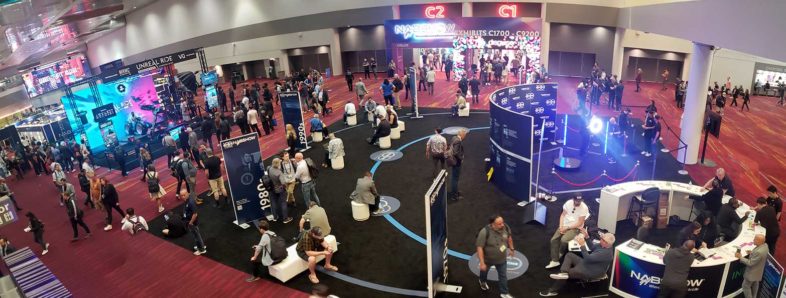 Dell
Dell
Dell had their recently announced 6K HDR computer monitor on display, as well as their new mobile workstations with 13th Gen CPUs and Ada GPUs. I used to be all about the most powerful desktop replacement I could get my hands on, but now that technology has progressed, I am finding that my needs (high res screen and NVidia GPU) can usually be met by lighter weight system, for more portability and battery life. Apparently 16” is the cool new size, matching the MacBook Pro, and Dell’s thin and light Precision 5680 seems like a good balance of portability and performance in that space, although they also have a 14” option in the Precision 5480 that appears to pack a punch, with 14 core CPU and Ada 3000 GPU. On the desktop workstation side, they are all-in on the new single socket Xeon’s, with the rack mount workstation being the only model that supports dual socket CPUs. I expect the rest of the major vendors to take a similar path by the next generation. The market for greater than 56 cores is minimal at the moment.
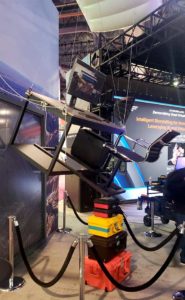 Z by HP
Z by HP
HP was showing off their newly updated workstations, with Intel’s new Sapphire Rapids Xeon CPUs, and had the one that they parachuted out of a plane as a release stunt on display. They also had a full virtual production environment setup in their booth, to interview various industry partners, while demonstrating that their hardware can drive the LED screens needed to provide the 3D environment in the background. They also were demonstrating their recently announced HP Anywhere hardware solution for remote workstation access and control.
AMD
AMD had a variety of displays in their booth, and was showing off various use cases for both their Threadripper Pro CPUs, and their newly announced Radeon Pro W7900 and W7800 graphics cards. Their new GPUs look fairly impressive on paper, so it will be interesting to see if these new models are finally able to make a dent in NVidia’s dominance in the pro visualization market.
NVidia
NVidia didn’t have their own booth, but had a presence with a number of their partners. In the IP video space, they were showing off the ways their Mellanox Connect-X and Bluefield cards are optimal solutions for IP video. Their Red Connect demo showed live GPU debayering of a Red RAW feed at 8Kp60, and then NvEnc compression to AV1 to stream it onward in real time, which is pretty impressive. They also have 2110 input and output solutions that run on their cards, with Bluefield DPUs having integrated support for the PTP timings required to keep things in sync. They were demonstrating software that creates a virtual display from the GPU that is actually being output from the network card as a 2110 signal, and then directing the output from Premiere Pro to that virtual display via Transmit, with that output being viewed on another system via RiverMAX viewer. Because it appears in software as a display connected to the GPU, this approach can be used by nearly any application that supports a full screen output, including mirroring of UI outputs, for streaming competitive gaming. So the gamer sees their monitor as usual, but the GPU is also sending a copy of the output to the network, to be output as an uncompressed stream that can be routed to a video switcher or recording device. They were also talking about new support for 2110 output from Unreal Engine 5.1 via RiverMAX on Bluefield DPU cards.
25GbE Networking
In the realm of faster networking options, Sonnet Technologies is launching 25GbE adapters, with both PCIe card and Thunderbolt box options available. QNAP also now has a 16 port 25GbE switch, which seems ideal for smaller groups of artists who need to make the jump to 25Gb communication.
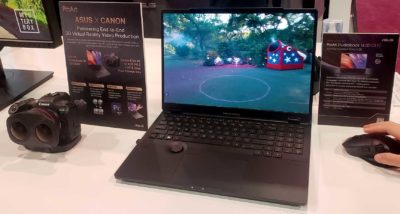 Smaller Vendors
Smaller Vendors
ASUS was showing off both monitors and entire computer systems targeted toward content creators. My favorite was a laptop with a glasses free 3D screen, based on live head tracking, and apparently they are working on a plugin to allow editing 3D in Premiere Pro on that display, without 3D glasses. I am not convinced of the market for stereoscopic content, but it it undeniably a fun technology, and more comfortable to use than previous solutions. While I was at ASUS’s booth, I saw a presentation by Puget Systems’ Matt Bach, who has been doing some great work in benchmarking and hardware analysis, the results of which are freely available on their website, and a valuable resource for those trying to find the best hardware for their particular workflows. Puget Systems had a booth of their own, where they were showing their newest workstations, and they are very knowledgeable about the needs in the industry.
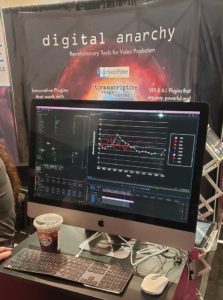 Digital Anarchy was showing off a new plugin, called Data StoryTeller, for converting large complex data sets into visualized graphics. I admit that this doesn’t sound as exciting as it actually is. I wasn’t impressed until I saw it in action, but they have done a lot of work with presets and templates to make it easier to get started with these types of workflows, and getting your data visualized in front of your viewers in compelling ways has never been easier, especially for non-designers like myself.
Digital Anarchy was showing off a new plugin, called Data StoryTeller, for converting large complex data sets into visualized graphics. I admit that this doesn’t sound as exciting as it actually is. I wasn’t impressed until I saw it in action, but they have done a lot of work with presets and templates to make it easier to get started with these types of workflows, and getting your data visualized in front of your viewers in compelling ways has never been easier, especially for non-designers like myself.
Cameras
I don’t do much with cameras directly anymore, but I always like to check out what is new in that world, since I will eventually have to be editing the footage that these things are recording. Sony was showing off the Venice2 used for virtual production in combination with their LED wall displays. They also had a volumetric display for viewing 3D assets, based on facial tracking and a 45 degree screen. I am not sure what format they use to drive the display, or if it is an entire computer unto itself. 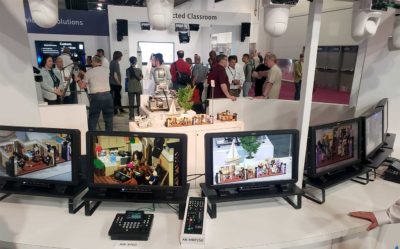 Panasonic was showing a high tech classroom, and had a large demonstration of PTZ cameras, using Lego models as their shooting environment, as well as one mounted to some sort of wave table to demonstrate an impressive level of image stabilization.
Panasonic was showing a high tech classroom, and had a large demonstration of PTZ cameras, using Lego models as their shooting environment, as well as one mounted to some sort of wave table to demonstrate an impressive level of image stabilization.
The Loop
And it would appear that a trip to NAB will no longer be complete without a ride in “The Loop.” The new West Hall can be a bit of a trek from the rest of the convention center, but The Loop offers quick access from South or Central Halls on board a fleet of Tesla sedans in tunnels 40’ underground. I tried it, just for the experience, and it was interesting to see the system at work, with scores of drivers maneuvering their cars into tight stalls with riders queued up by target destination. The tunnels themselves are a narrow bore, and not for the claustrophobic, but they zoom under all of the traffic, right to your destination. It is like a manpower intensive on-demand subway system, and I took forward to seeing how it expands with new connections in the coming years.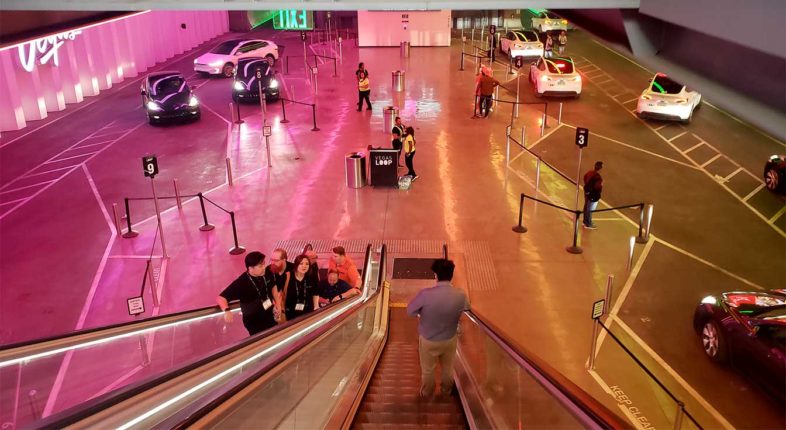
Disclosure: I have done contract work, directly or indirectly, for Adobe, AJA, and Cinnafilm in the past.

